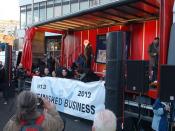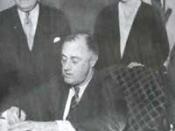�PAGE � �PAGE �8� Collective Bargaining
Collective Bargaining
Sheilah Dillon
University of Phoenix
Human Resources Seminar in Problem Solving - MBA591
February 23, 2009
�
Collective Bargaining
This paper will analyze and evaluate the conditions in product and service markets that lead to collective bargaining, while conversing through union membership, National Labor Relations Board (NLRA), Taft-Hartley Act, and the role of human resources. Collective bargaining is a process that involves the negotiation, drafting, administration, and interpretation of a written agreement between an employer and a union for a specific time (Byars & Rue, 2004). Collective bargaining is the practice in which union and company representatives meet to negotiate a new labor contract and the backbone of labor relations for Americans. Collective bargaining is known to be done face-to-face with negotiations involving give and take on the part of both management and labor representatives. Through these negotiations that both sides attempt to understand the positions of the other and attempt to persuade the other side of the fairness of their own demands.
Union Membership
Unionized work places are generally less popular than nonunion work places. This is usually caused by an employer increasing benefits and wages due to a union bargain agreement. The unions played a role in transforming American industry and the America quality of life today. However, due both to the nature and the state of global business, labor unions are less relevant, necessary, and beneficial today than in the past. They are less needed as many laws now champion workers' rights less relevant as business becomes increasingly globalize, and less beneficial as they often fail to represent the best interests of employees, employers, and stakeholders. Both women and other minority-group members, who are expected to continue entering the workforce at a high rate, tend to favor unions (Cascio,


